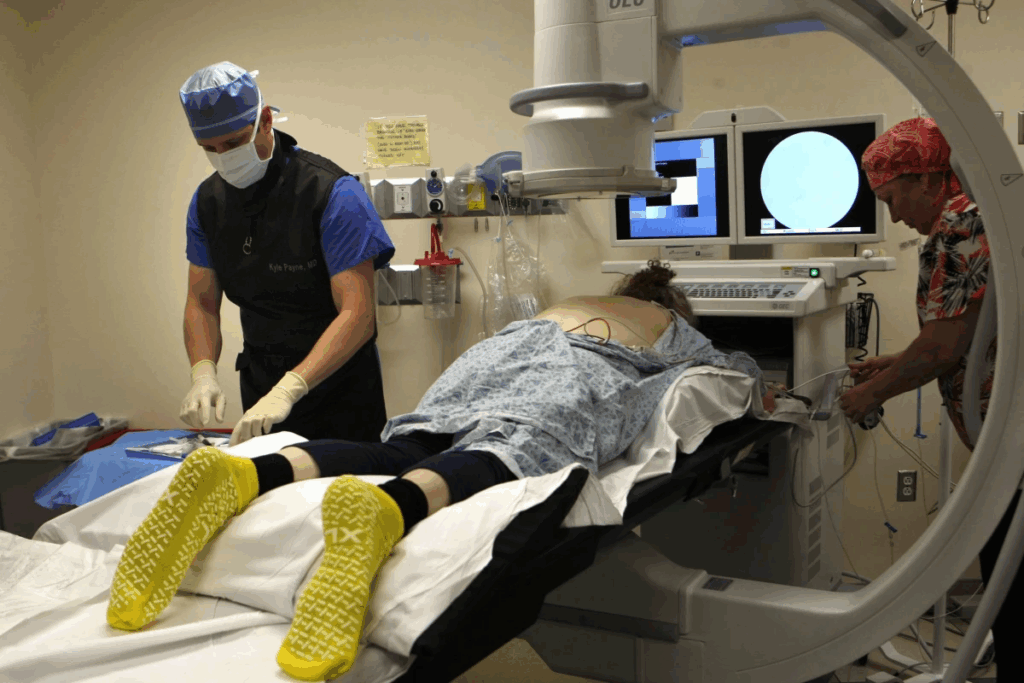
Understand how epidural steroid injection vs cortisone injection differ for managing pain and inflammation. Are you dealing with ongoing back or joint pain? You might be thinking about getting an epidural steroid injection or a cortisone shot. It’s important to know the differences between these treatments.
At Liv Hospital, we focus on you and your health. We give you clear information and the best treatments available. Some injections can offer short-term relief, but their lasting effects vary.
We want to help you understand the differences. This includes how each treatment is done and when they’re used. We aim to guide you in choosing the right option for your pain.

Injections for pain management are becoming more popular. They work by sending medicine straight to the pain spot. This method can offer relief with fewer side effects than pills.
Injectable medicines are key in fighting pain. Anti-inflammatory injections help by cutting down swelling and pain. They’re used for arthritis, tendinitis, and bursitis.
By putting the medicine right where it’s needed, these injections can be more effective. This means better pain relief for patients.
Anti-inflammatory injections have corticosteroids, strong fighters against inflammation. They work by lessening swelling and pain. This helps improve function and quality of life.
These injections don’t cure the problem but offer symptomatic relief. It’s important to know they’re not a fix-all solution.
Pain management injections, like anti-inflammatory ones, aim for symptomatic relief. They help reduce pain and swelling. This makes it easier for patients to handle their condition and do physical therapy.
Even though these injections are effective, they don’t solve the root cause of pain. Sometimes, a mix of treatments is needed for the best results. We suggest a plan that includes injections, physical therapy, and more, based on the patient’s needs.

Epidural steroid injections are a key treatment for many spinal problems. They put anti-inflammatory medicine right next to the spinal cord. This helps people with pain that starts in the spine.
Epidural steroid injections are a anti-inflammatory treatment. They put corticosteroids into the epidural space. The goal is to lessen swelling and pain around the spinal nerves.
“Epidural steroid injections are effective for many spinal pain issues,” says a top pain management doctor. “They can greatly reduce symptoms for patients.”
The epidural space is a fatty area between the vertebrae and the spinal cord’s protective sac. It’s important for placing medication near inflamed nerves. Knowing the epidural space’s anatomy is key for precise injections.
There are different types of epidural injections:
Each injection type is chosen based on the patient’s needs and the doctor’s advice.
Cortisone injections are a way to manage pain and inflammation. They are used to treat pain and swelling in different parts of the body.
Cortisone injections, also known as corticosteroid injections, are given directly into a joint, tendon, or bursa. They aim to reduce inflammation and pain. This treatment is for people with inflammatory conditions that cause pain and discomfort.
The injections contain synthetic versions of cortisol, a hormone our bodies make. They work by lowering the immune system’s response to inflammation. This helps reduce pain and swelling.
Cortisone injections can be given in many parts of the body. They are used in areas with inflammation or pain. Common places include:
These injections are great for treating tendinitis, bursitis, and some types of arthritis.
There are several types of corticosteroids used in cortisone injections. Here are a few:
| Corticosteroid | Duration of Action | Common Use |
| Triamcinolone | Intermediate-acting | Joint and soft tissue injections |
| Methylprednisolone | Intermediate-acting | Joint injections |
| Betamethasone | Long-acting | Soft tissue and joint injections |
The type of corticosteroid used depends on the condition, how severe the inflammation is, and the patient’s medical history.
Choosing between epidural steroid injections and cortisone injections depends on their differences. We’ll look at these differences to help decide when to use each.
Epidural steroid injections target the epidural space around the spinal cord. This area is key for treating spine-related pain. Cortisone injections, on the other hand, are for joints, tendons, or bursae, treating inflammation there.
The main difference is where each injection is used. Epidural injections are for spine issues like radiculopathy and spinal stenosis. Cortisone injections are for joint and tendon inflammation.
How each injection is given also differs. Epidural injections need precise placement with imaging like fluoroscopy. Cortisone injections might not need imaging, depending on the location.
Key differences in administration techniques include:
Both types use corticosteroids, but the mix and dose can differ. Epidural injections have a corticosteroid and a local anesthetic for pain relief. Cortisone injections have corticosteroids, but the type and dose vary by condition.
The choice between epidural steroid injections and cortisone injections should be based on a thorough evaluation of the patient’s condition and the specific characteristics of each injection type. Understanding these differences helps healthcare providers choose the best treatment for their patients.
Epidural steroid injections are a key treatment for spinal pain. They work well for conditions that cause nerve inflammation and compression.
Epidural steroid injections are often used for herniated discs. This happens when the soft center of the disc leaks out. It can cause pain and numbness along the nerve path, known as radiculopathy.
“The injection of corticosteroids into the epidural space can significantly reduce the inflammation around the affected nerve root, alleviating pain and improving function,” studies show.
Symptoms of herniated discs include sharp pains and numbness in the neck or back. Epidural steroid injections can help by reducing inflammation and easing symptoms.
Spinal stenosis is another condition treated with these injections. It’s when the spinal canal narrows, putting pressure on nerves. This can cause pain, numbness, or weakness in the back, legs, or arms.
Spinal stenosis can make everyday activities painful. Epidural steroid injections offer a non-surgical way to manage symptoms, potentially avoiding surgery.
Sciatica is pain that follows the sciatic nerve path. It’s often caused by nerve compression or irritation, like from a herniated disc. Epidural steroid injections can reduce inflammation around the sciatic nerve, easing pain.
Nerve compression syndromes, including sciatica, can greatly benefit from these injections. They not only relieve pain but also improve function by reducing nerve inflammation.
Cortisone injections are a key treatment for many inflammatory conditions. They help manage pain and swelling in different parts of the body. This is very helpful for musculoskeletal disorders.
Cortisone injections are mainly used for joint inflammation and arthritis. These conditions cause a lot of pain and stiffness. The injections reduce swelling, easing pain and improving joint movement.
A study in the Journal of Orthopaedic Research showed cortisone injections help a lot. They reduce pain and improve function in knee osteoarthritis. A researcher said, “Corticosteroid injections are a valuable treatment option for patients with osteoarthritis, providing both pain relief and improved function.”
“Corticosteroid injections are a valuable treatment option for patients with osteoarthritis, providing both pain relief and improved function.”
– Journal of Orthopaedic Research
Cortisone injections also treat tendinitis and bursitis. Tendinitis affects tendons, like in the elbow or shoulder. Bursitis affects bursae, like in the shoulder, hip, or knee.
These injections reduce inflammation, easing pain and improving movement. Below is a table showing common conditions treated with cortisone injections and their symptoms.
| Condition | Symptoms |
| Joint Inflammation | Pain, stiffness, swelling in the joints |
| Tendinitis | Pain, tenderness, limited mobility in the affected tendon |
| Bursitis | Pain, swelling, limited mobility in the affected bursa |
Cortisone injections also treat other inflammatory disorders. These include plantar fasciitis, trigger points, and nerve compressions. Their versatility makes them a valuable tool in treating many painful conditions.
Cortisone injections are very effective for many inflammatory conditions. Knowing which conditions they treat helps healthcare providers offer better relief. This improves patients’ quality of life and function.
Understanding epidural steroid injections and cortisone injections is key for pain management. Both aim to provide relief but differ in their methods.
Epidural steroid injections put medication around the spinal cord. They use imaging like fluoroscopy for accurate placement.
Imaging helps us see the spine and guide the needle. This makes the injection more precise and safer.
“The use of imaging guidance during epidural steroid injections has become a standard of care, allowing for precise delivery of medication to the affected area.”
The steps for this procedure are:
Cortisone injections put medication into joints or soft tissue. It’s a simpler procedure done in a clinic.
We numb the skin with local anesthetic before the injection. Ultrasound or palpation guides the injection for accuracy.
| Procedure Step | Epidural Steroid Injection | Cortisone Injection |
| Imaging Guidance | Fluoroscopy | Ultrasound or Palpation |
| Medication Target | Epidural Space | Joint or Soft Tissue |
Both procedures aim to reduce pain. We use local anesthetics and gentle techniques.
Pain management techniques include:
Knowing what to expect helps patients prepare for treatment and recovery.
The recovery and pain relief timeline can differ a lot between epidural steroid injections and cortisone injections. Knowing these differences is key to managing your expectations and making smart choices about pain management.
Right after getting an epidural steroid or cortisone injection, you might feel different things. Epidural steroid injections can cause:
Cortisone injections might lead to:
The time it takes for pain relief to start is different for each type of injection. Epidural steroid injections usually take 2 to 7 days to work, as they reduce inflammation around the nerves.
Cortisone injections can start working in a few days to a week. This depends on the condition being treated and how well you respond to the corticosteroid.
The length of time pain relief lasts also varies. Epidural steroid injections can offer relief that lasts several months in some cases. But, the effect can vary a lot among people.
Cortisone injections usually provide relief that can last from a few weeks to several months. How long it lasts depends on the frequency and severity of your condition.
By understanding the recovery process and pain relief timeline for both epidural steroid injections and cortisone injections, patients can better navigate their treatment options and make informed decisions about their care.
It’s important to know how well epidural steroid injections and cortisone injections work. This helps doctors choose the best pain relief options. We look at the research to make these choices.
Both types of injections help with pain, but for how long can vary. Short-term relief is common, giving quick pain relief. But, how long they last can depend on the condition and the person.
A study in the Journal of Pain Research showed epidural steroid injections help with short-term pain in the back. But, the long-term benefits were not as clear (1). Cortisone injections also offer quick relief for inflammation, but their long-term success is not always the same.
How well these injections work depends on several things. This includes the condition being treated, how accurate the injection is, and the patient’s health. For example, how much inflammation there is and how bad the symptoms are can affect how well they work.
“The success of epidural steroid injections depends a lot on getting the steroid to the right place. This is why using imaging during the procedure is so important.”
New studies are helping us understand more about these injections. They look at the best dose, which steroids work best, and how they compare for different pain problems.
A review of studies on back pain found that epidural steroid injections work better in the short term than cortisone injections (2). But, more research is needed to fully understand their benefits and limitations.
As we learn more, we can better use these injections to help people manage their pain. We can tailor treatments to meet each patient’s needs.
When thinking about epidural steroid injections or cortisone shots for pain, knowing the risks and side effects is key. These treatments help manage pain but can have risks that differ in severity.
Epidural steroid injections are usually safe but can cause side effects. Common ones include:
These side effects are usually mild and go away in a few days. But, it’s important to watch your symptoms and talk to your doctor if you have any worries.
Cortisone shots also have common side effects, some similar to epidural steroid injections. These can include:
Like with epidural steroid injections, these side effects are usually short-lived. But, talk to your doctor if they last longer or get worse.
While rare, serious complications can happen with both types of injections. Knowing the warning signs is important:
If you see any of these symptoms, get medical help right away. Also, follow up with your doctor as planned to check how the treatment is working and address any issues.
It’s vital to understand the risks and side effects of epidural steroid injections and cortisone shots for pain relief. Both treatments can be effective, but knowing the possible complications helps you stay safe and seek help when needed.
Choosing the right pain treatment is key. We’ve looked at epidural steroid injections and cortisone injections. These are two common treatments for pain.
Which one you choose depends on your pain and personal health. Epidural steroid injections help with herniated discs and sciatica. Cortisone injections are for joint pain and tendinitis.
Talking to a healthcare professional is important. They can help pick the best treatment for you. Knowing the differences helps you manage your pain better.
Understanding your needs and medical history is vital. Working with your healthcare provider is essential. They can guide you to the best treatment.
Epidural steroid injections target the area around the spinal cord. They help with pain from spinal issues like herniated discs and sciatica. Cortisone injections, on the other hand, go directly into joints and tendons. They’re used for conditions like arthritis and tendinitis.
Yes, they are all steroid injections. They contain corticosteroids, which fight inflammation. “Cortisone injection” is a specific type, but the terms are often used together.
They both reduce inflammation. Corticosteroids in these injections calm the immune system’s inflammation. This lessens swelling and pain, giving relief and improving function.
Side effects include pain at the site, temporary pain increase, and flushing. Serious but rare issues like infection and nerve damage can happen. Proper technique and clean conditions can lower these risks.
Relief times vary. Some feel better in days, while others take weeks. Relief can last from weeks to months, depending on the condition and response.
Yes, they can be part of a bigger pain management plan. This might include physical therapy and medication, tailored to the individual’s needs.
Certain conditions, like infections and allergies, may not be treated with these injections. Always talk to a healthcare professional about the best treatment for your condition.
For back pain, cortisone and steroid shots are the same. They both use corticosteroids to reduce inflammation and pain.
The way they’re given is different. Epidural injections go into the space around the spinal cord, guided by X-ray. Cortisone injections go directly into joints or tendons, depending on the area.
Subscribe to our e-newsletter to stay informed about the latest innovations in the world of health and exclusive offers!
WhatsApp us